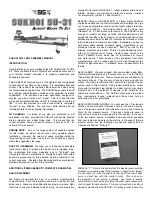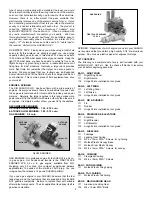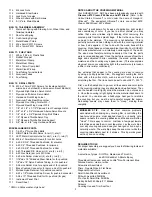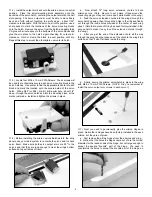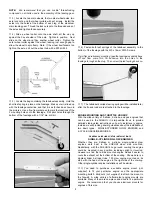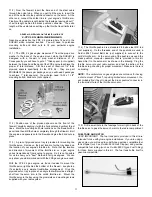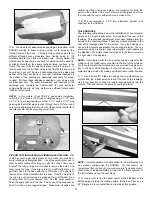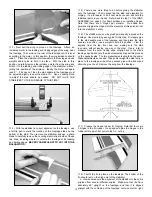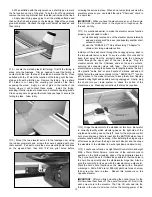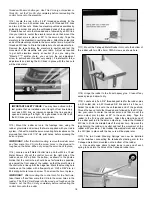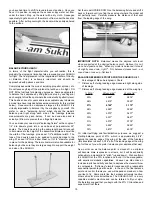
14
❑
5) There’s one more thing to do before gluing the stabilizer
onto the fuselage! That is preparing the stab and elevators for
hinging. It’s a lot easier to do it now while you can still hold the
individual parts in your hands. Refer back to step 7 of the WING
ASSEMBLY (on page 5) for basic guidance on installing hinges.
Note that there are 3 hinges per elevator.
Go ahead and
permanently glue the hinges into the elevators at this point, but not
into the stabilizer. Let dry.
❑
6) The stabilizer can now be glued permanently in place on the
fuselage. Use slow-drying epoxy glue for this step. First apply glue
to the stab saddle area of the fuselage and then place the stab
squarely in position - use a weight to hold it in position. View the
airplane from the top, front and rear, making sure the stab
is square, without leaning one way or the other. Use a ruler to
measure from the outer trailing edge wingtip back to the stab's
leading edge tip and note the measurement and repeat this process
on the opposite side. The two measurements should be the same.
Make adjustments as needed. Tape and/or weight the stab firmly in
place to the fuselage, wipe off any excess glue with alcohol and
allow the glue to set. Remove the wing from the fuselage.
❑
7) Prepare the fin and rudder for hinging. Note that there are
3 hinges in the fin/rudder. Go ahead and glue the hinges in the
rudder at this point, but not into the fin. Let dry.
❑
8) Trial fit the fin in place on the fuselage. The bottom of the
fin should rest on the high point of the stabilizer.
a. View and measure the alignment of the stabilizer to the entire
airplane from several different angles. Make sure that the fin is
absolutely 90
O
upright on the fuselage, and that it is aligned
straight with the centerline of the fuselage, not turned left or right.
❑
3) Next bolt the wing in place on the fuselage. Attach an
incidence meter to the leading and trailing edges of the wing, near
the fuselage. Then prop up the rear of the fuselage until it is level
according to the meter. In this position, the wing incidence should
read 0°. Place the stabilizer into its saddle in the fuselage and use
weights and/or pins to hold it in place.
With the stab in this
position, carefully remove the incidence meter from the wing and
attach it to the leading and trailing edge of the stabilizer, without
jarring the position of the airplane. Ideally the meter will again
read 0°. If it does not, then the stab saddle in the fuselage must
be adjusted slightly to seat the stab at 0
O
. Use a sanding block
to adjust the stab saddle as needed.
DO NOT GLUE THE
STABILIZER TO THE FUSELAGE AT THIS TIME!
❑
4) With the stabilizer in correct alignment on the fuselage, use
a felt-tip pen to mark the location of the fuselage sides on the
bottom of the stab. Then remove the stabilizer and use a sharp
blade to carefully remove the covering material just inside of these
two lines, including where it contacts the fuselage at its leading
and trailing edges. BE VERY CAREFUL NOT TO CUT INTO THE
BALSA WOOD!
Summary of Contents for SUKHOI SU-31 ARF
Page 23: ...23 ...

